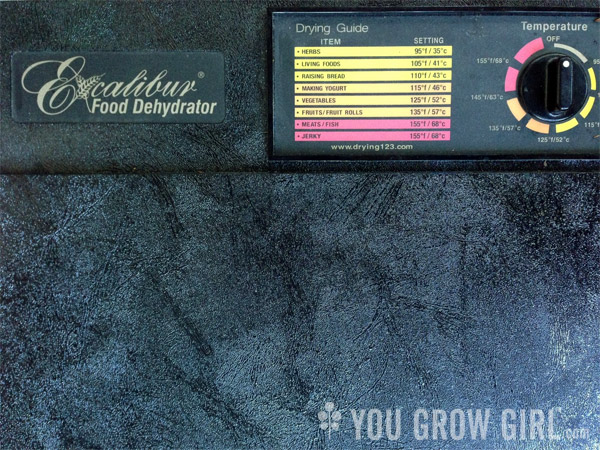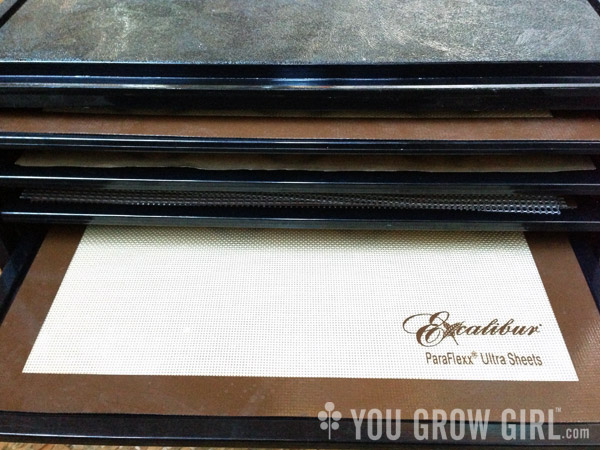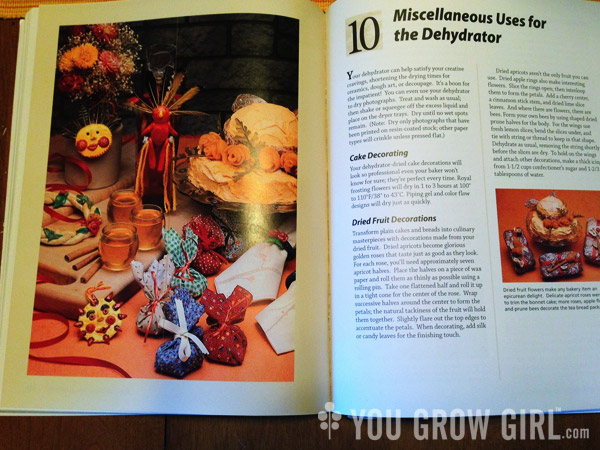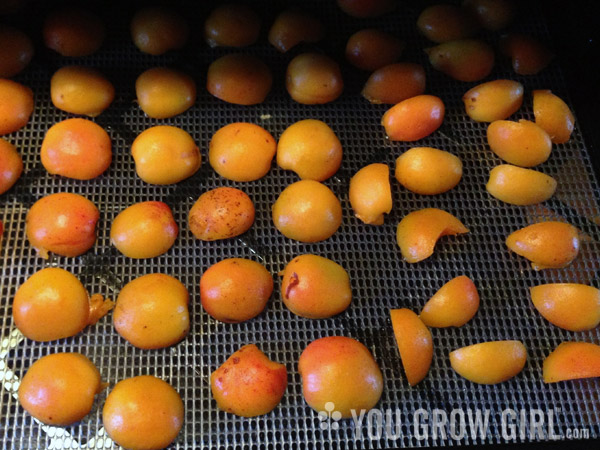
My friend Abbey has lent me her Excalibur 9 Tray Food Dehydrator for the weekend. This gorgeous beast is the queen of dehydrators. I used to wonder if it was worth the expense or if the excitement around it was mostly hype. I was officially sold when Abbey bought hers (the machine I am borrowing now) and offered me a taste of her first batch through it, peach slices that were truly dry, crisp, and absolutely perfect.

I currently own a much cheaper Nesco 600-watt machine and would never dream of using it to dehydrate anything fleshy or wet. It’s an economical machine if you plan to stick with herbs, some spices, tomato skins, and maybe the odd hot pepper, but the poor thing could not dehydrate a peach to save its life. Believe me, I’ve tried. Wet fruit caramelizes and often burns. It also happens to take days upon days to achieve this less than desired outcome — not the most economical use of electricity. On the other hand, Abbey’s beautifully crisp peach slices were made in the Excalibur overnight. She has since allowed me to try several other delicious food stuffs preserved in her machine, including fruit leathers made with yoghurt and even milk kefir. They were all gorgeous and so much nicer than those I have made in the oven.

While helpful, the instruction book that came with the machine is a “little bit” dated.

And so here I am with this machine for the next few days and a whole world of food dehydration before me. What to make? My first batch of apricot halves are in the machine as I type this. As per the directions in the book that came with the machine, I soaked the pieces in a solution of lemon juice and honey to prevent the fruit from browning. As an early birthday gift, Abbey generously gifted me a big bag of apricots (as well as a few peaches). She picked it locally with Not Far From the Tree, an urban fruit picking/sharing program here in Toronto. Much of the fruit is still a little green so I will get to the rest later in a few days. I hope to pick up some organic peaches at the market to try my hand at peach and lavender fruit leather in the machine. I also have a bounty of newly harvested ‘Egyptian Walking’ onions and garlic from the garden and will likely dry some of those as well for winter storage, although obviously not at the same time as the fruit.
If you have this machine or something similar, I’d love to hear from you. What have you made? Any tips and tricks are much appreciated!
———–
Disclosure: Please note that affiliate links within this post earn me a small commission, which goes towards giveaway prizes and sustaining the site. Please see my current Publication Policy for more info.
Holy wow that is quite a price difference between the Excalibur and the Nesco. I wish I had read this review a week ago. I have the Nesco FD-60 (a 500-watt machine) scheduled to arrive today, and was hoping to use it for making jerky and sun-dried tomatoes.
By the way .. it’s probably not too late to return your machine and pay a small handling fee — I don’t see those non-Excalibur machines fetching more than about $35-50 max around here..
Try checking the local Craigslist editions to see if someone is selling one.. I’m in the Los Angeles area and they do pop in from time to time.. We had two pop up within the past week — one a 5 tray for $150 and I missed a deal on a 9-tray model for $120.. Ugg!
Do you think you could cut the food your drying “Allot Thiner”, and you could use a less expensive Machine?
I’m growing allot of Cantaloupe, Can you dry Cantaloupe in less expensive machines?
Thanks,
Annie
Anything I have tried to dehydrate has been done at a range of thicknesses. I always experiment to determine what works best for a specific crop.
Melons are listed in the Excalibur book under “Poor for Drying.” I have never tried.
Oppsss, But can you even dry Cantaloupe?
Hmmm, I wonder if climate is a factor, because I have a cheaper Nesco and I have always been successful with it. I do live in the desert so that could be in my favor. Also I always slice things pretty thin. I have never tried jerky, but I have dried all kinds of fruits and herbs.
Climate is absolutely a factor. Summers in Toronto are hot and humid. Dehydrating in the desert would definitely be much more effective.
We’ve had our Excalibur 9-tray for about a year. It is one of our must-have kitchen appliances. I am currently drying soaked walnuts. My Instagram account has a few photos of some of the stuff we have dehydrated. Favorites are fruit, fruit leathers, nuts, yogurt & creme fraiche – keeps the temp up. So many uses!!!
Here’s one photo: https://www.facebook.com/photo.php?fbid=622718114413800&set=a.338678099484471.90584.260113470674268&type=1&theater
Anya,
Your picture looks Yummy.
But can’t you do the same drying in your Oven in the winter? Or a Warming drawer in your oven?
How in the world do you dry, Yogurt & Creme Fraiche .
Thanks..
Hi Annie,
Yes, oven works for a lot of things and gives an extra crispiness…
Yogurt & creme fraiche are used without the trays inserted to keep the temperature up.
:)
I’ve used a RonCo something or other dehydrator I borrowed, an American Harvest dehydrator I picked up at a yard sale, and I now LOVE my Excalibur. It’s pretty amazing. I’ve done banana chips (plain, and sprinkled with any of: curry, red pepper flakes, cinnamon, ginger), apple chips (sliced and minced small enough to use on salads or add to steeping tea), fruit leather (by itself or mixed half and half with yogurt, and using a berry mix or stewed pumpkin with cinnamon and nutmeg and ginger), berries (I just did a batch of whole blueberries and pitted cherries) and I’ve dried all manner of herbs in it. I’ve made yogurt in the dehydrator, and beef jerky too. I haven’t used it for proofing bread, so I can’t speak to that. I also don’t use it for non-edible materials (like clays), just out of personal preference.
The hard part about drying in your oven is having an oven that goes to low enough temperatures in the first place. Not everyone’s oven goes below 200F, and a lot of dehydrating is best done between 95-135F.
The Excalibur isn’t cheap, but then… it isn’t cheap. It isn’t small either, which means I can have a whole bunch of stuff going at the same time.
I live in the Pacific Northwest where we have a fair bit of humidity and it only gets really warm maybe a month or two of the year. I like being able to dehydrate things in 24-48 or so hours. Any longer than that, and I have a tendency to forget about it till it’s too late.
I have the for tray version of it and so far I have just dried bananas and apples (spiced and plain). Am hoping to get enough tomatoes in te garden to try those next. I also took it to the library to speed up drying time when I made seed paper with the Tweens. Love it.
I have the Excaliber 9 tray. I’ve dried jerky, fruit leather, strawberries. peaches, herbs, corn, blueberries, tomatoes, & hibiscus calyces (for tea). All were great. I love this machine!
We regularly soak and then dry nuts in our Excalibur 5-tray. I also frequently dry bananas for chips for my toddler and make fruit leathers. I’ll be drying some herbs this season, and I just dried my first batch of salmon jerky…delish!
What a great idea to dehydrate kefir! As a vegan I make a lot of non-dairy kefir and am currently experimenting with taking the kefir I make further. I added some of my organic soy and apple kefir to a can of coconut cream last night and this morning I have a most interesting bubbly creation that knocks the socks off commercial vegan yoghurt…might be time to puree some pears (it’s winter here) and add some of this “yoghurt” to them and make some more fruit leather in my excalibur. I am ashamed to admit that it has been languishing in the shed and is only used to make dehydrated dog treats at the moment! SHAME ON ME!!! You just invigorated my desire to use it all over again :). Cheers! :)